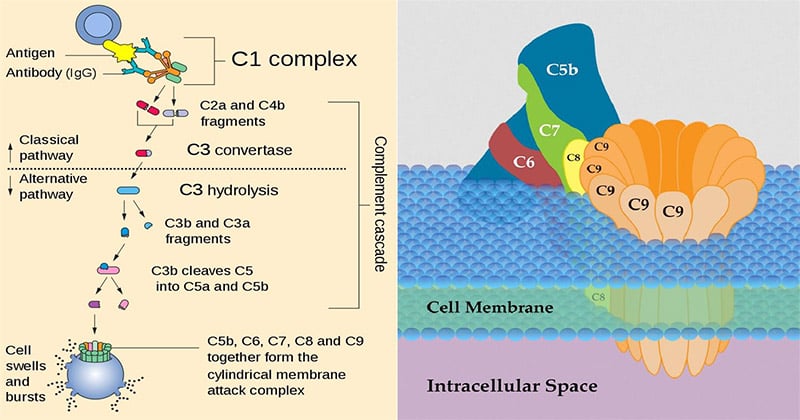Complement refers to a set of serum proteins that cooperates with both the innate and the adaptive immune systems to eliminate blood and tissue pathogens. Various complement components bind and opsonize bacteria, rendering them susceptible to receptor-mediated phagocytosis by macrophages, which express membrane receptors for complement proteins. Other complement proteins elicit inflammatory responses, interface with components of the adaptive immune system, clear immune complexes from the serum, and/or eliminate apoptotic cells. Finally, a Membrane Attack Complex (MAC) assembled from complement proteins directly kills some pathogens by creating pores in microbial membranes. Paul Ehrlich coined the term complement, defining it as “the activity of blood serum that completes the action of antibody.”

Complement is a complex system of enzymes, regulatory proteins, and cell surface receptors that are involved in host defense, inflammation, and modulation of immune responses. The system provides a fast-acting mechanism for the identification and removal of foreign substances, providing protection before the adaptive immune system can come into play. It is also involved in a wide variety of homeostatic processes including the clearance of immune complexes, effete cells, and cellular debris from damaged tissues.
The complement system is a part of the immune system that enhances (complements) the ability of antibodies and phagocytic cells to clear microbes and damaged cells from an organism, promotes inflammation, and attacks the pathogen’s plasma membrane.
The complement system consists of serum and cell surface proteins that interact with one another and with other molecules of the immune system in a highly regulated manner to generate products that function to eliminate microbes. Complement proteins are plasma proteins that are normally inactive; they are activated only under particular conditions to generate products that mediate various effector functions of complement.
Interesting Science Videos
Properties of Complement
Complement shows the following properties:
- It is present in sera of all mammals including humans and in lower animals including birds, amphibians, and fishes.
- These are heat-labile substances that are inactivated by heating serum at 56°C for 30 minutes.
- These are glycoproteins and are synthesized primarily by liver cells and to a very less extent by macrophages and many other cell types. The rate of synthesis of the various complement glycoproteins increase when complement is activated and consumed.
- The complement usually does not bind to the antigen or antibody but only to antigen–antibody complex.
- The importance of the complement lies in the fact that it contributes to both the acquired and innate immunity of an individual.
There are four main effects of complement:
- It causes lysis of cells (such as bacteria, viruses, allografts, and tumor cells).
- It generates mediators that participate in triggering specific cell functions, inflammation, and secretion of immunoregulatory molecules.
- It facilitates opsonization, the process by which bacteria are more readily and more efficiently engulfed by phagocytes.
- It causes immune clearance, in which immune complexes from the circulation are removed and are transported to spleen and liver.
Nomenclature of Complement
Complement components are designated by numerals, viz., C1–9. These components circulate in plasma in the form of proenzymes that are functionally inactive. Activation involves cleavage by proteolysis into peptide fragments. The fragments are designated with lowercase suffixes—for example, C3 is cleaved into two fragments, C3a and C3b. Normally, the large fragment is designated “b”, and the small fragment “a”. But for historical reasons, with respect to the fragments of C2, the large fragment is designated C2a and the small one is designated C2b.
